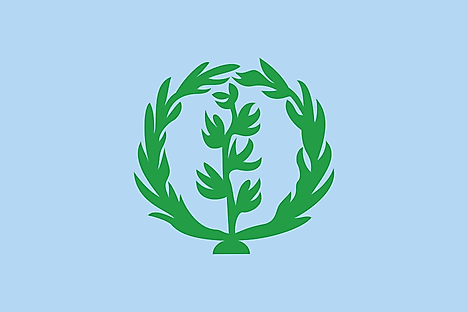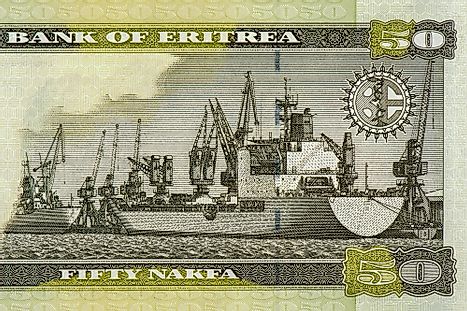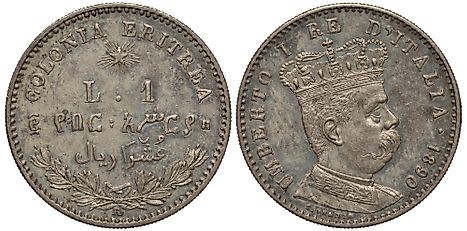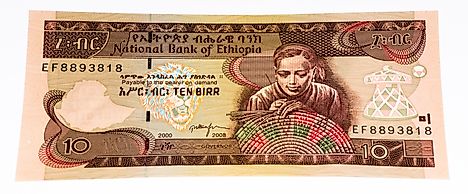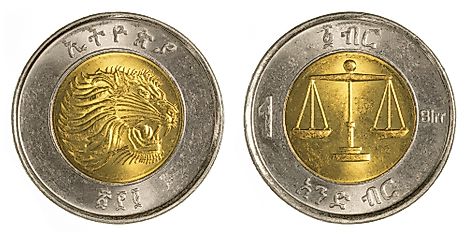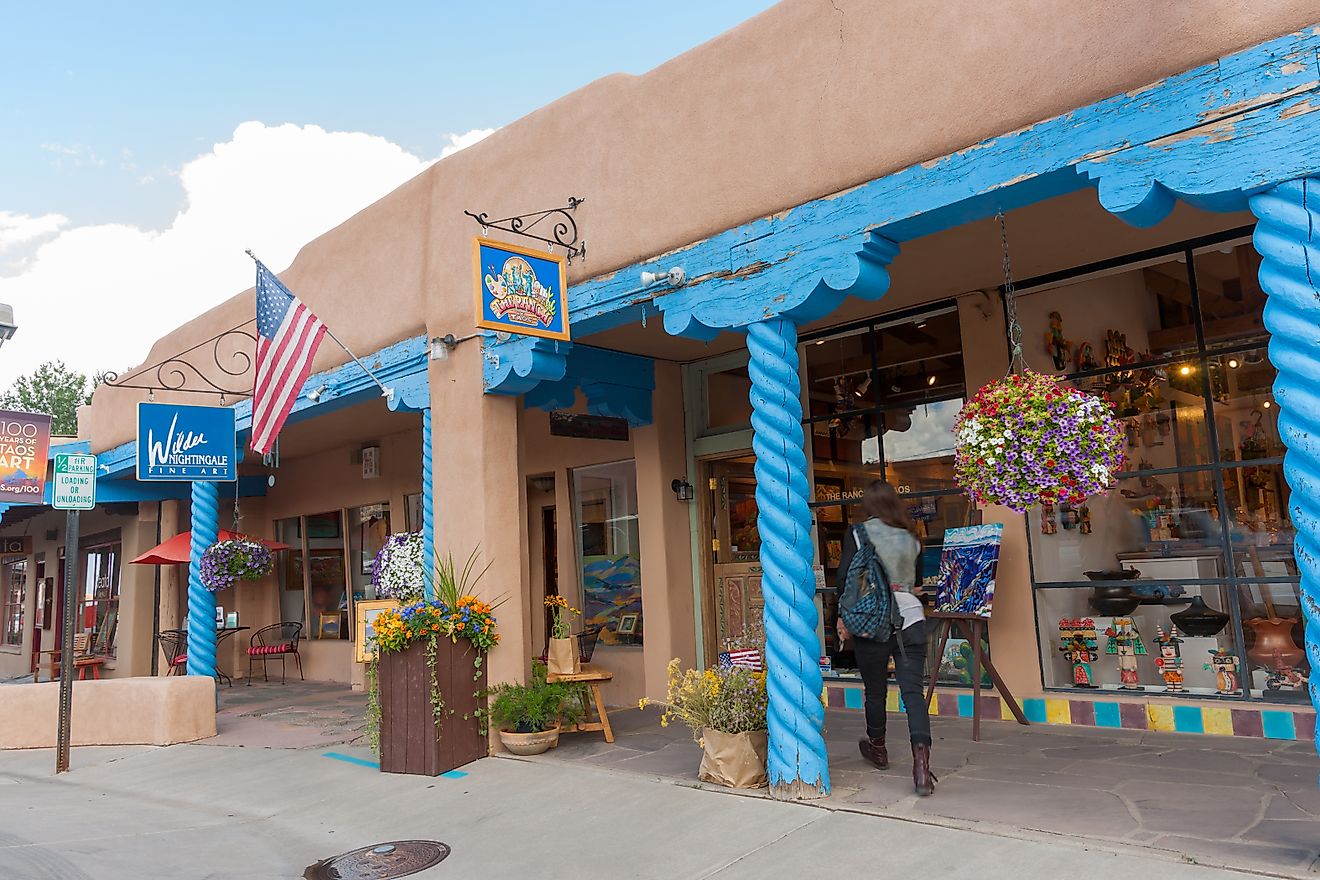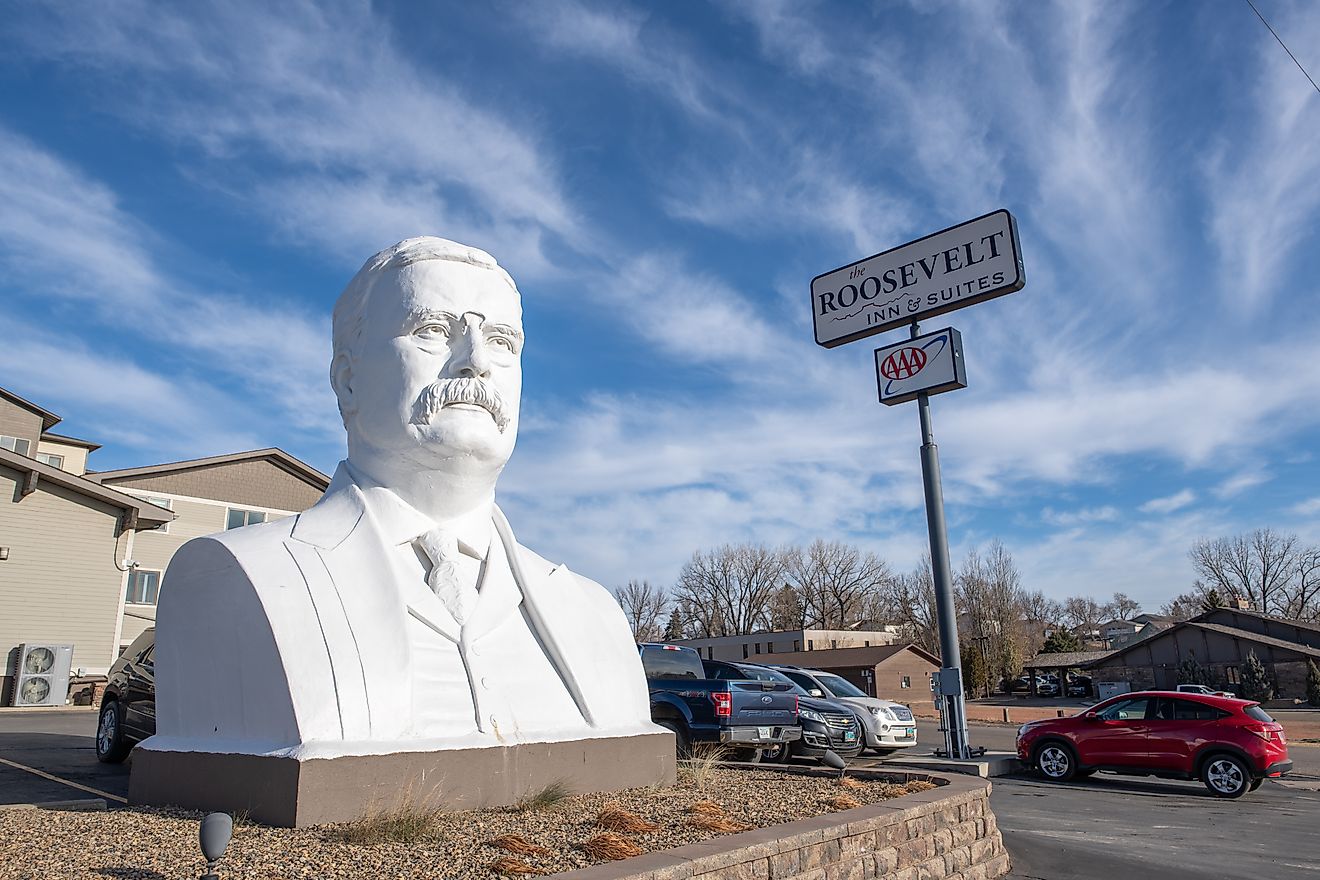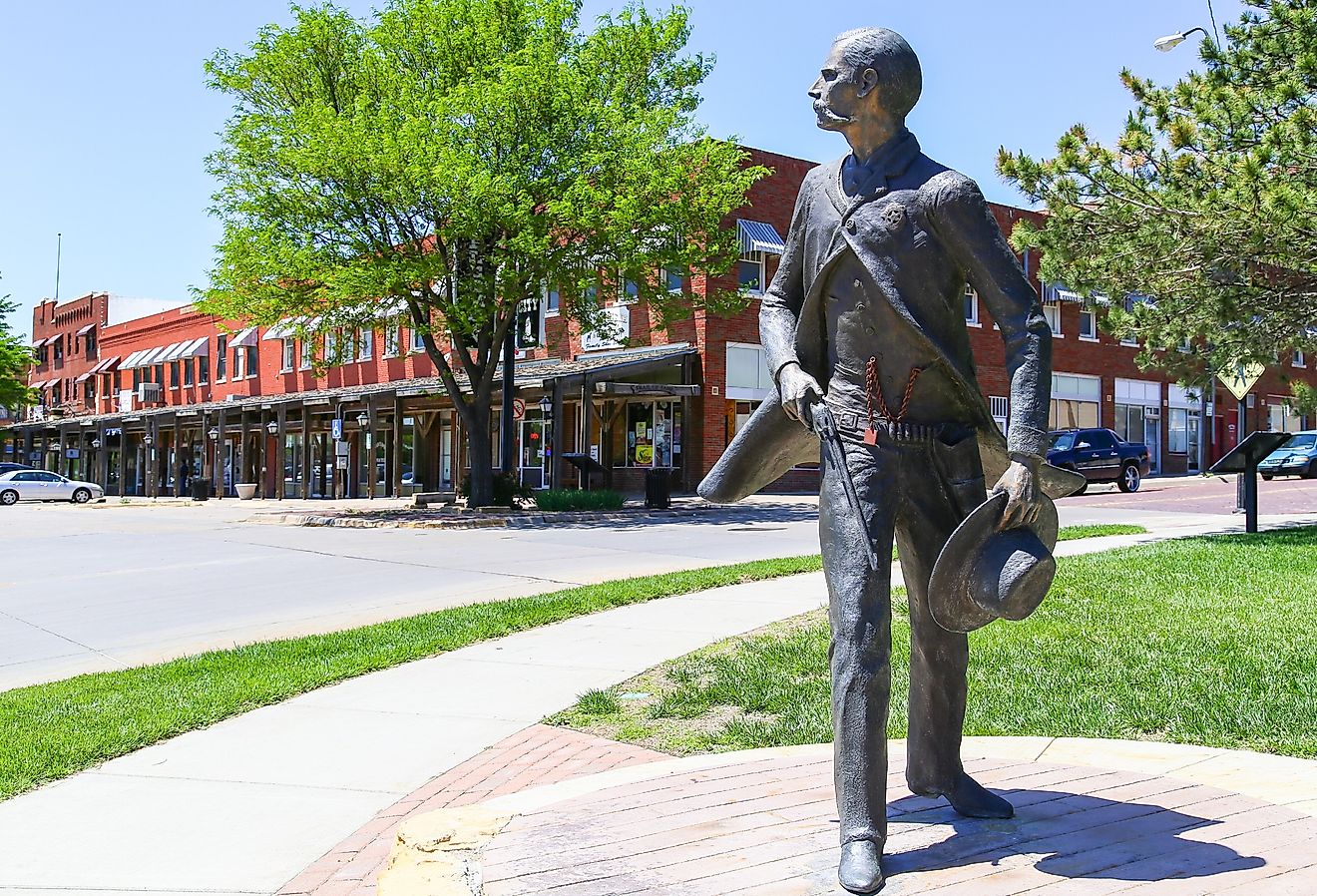Flags, Symbols & Currency of Eritrea
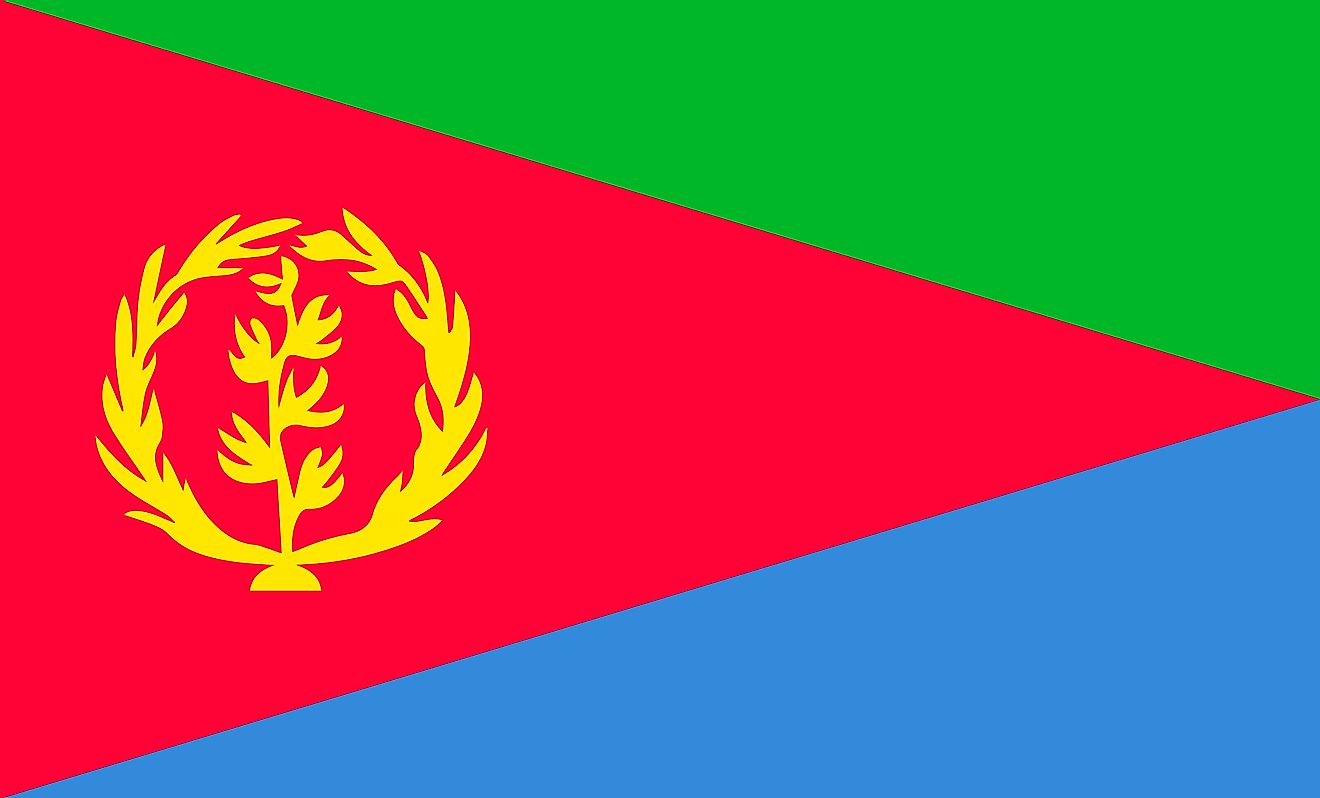
The National Flag of Eritrea was officially adopted on December 5, 1995.
The National Flag of Eritrea features three triangles of the colors red, green, and blue. The red isosceles triangle is based on the hoist-side and its point is on the fly-side. The shape of the red triangle broadly mimics the shape of the country. Two right triangles lie on either side of the red triangle, with both based on the fly-side. The point of the red triangle separates the bases of the green triangle on the upper side and the blue triangle on the lower side. Within the red triangle, there is a vertical gold olive branch encircled by a gold olive wreath. The olive branch and the wreath are centered on the hoist side of the red triangle. The green color symbolizes the country’s livestock and agricultural economy. The blue color symbolizes the bounty of the sea. The red color signifies the bloodshed in the fight for freedom. The olive wreath with 30 leaves represents the number of years for which the civil war was fought in Eritrea to attain independence. The red triangle, olive branch, and wreath collectively represent the country's autonomy. The flag has a width-to-length proportion ratio of 1:2.
History of the Flag of Eritrea
The modern-day country of Eritrea was formed by the unification of several kingdoms and sultanates existing in the region. The unification was brought about by the colonial rule of Italy in the region. After the Italians were defeated by the British army in Italian Eritrea in 1942, the country became a British-administered territory until 1952. After the British left Eritrea, a new flag was adopted as the flag of Eritrea on September 15, 1952, when Eritrea was still an autonomous region within Ethiopia. The flag of Eritrea featured a light blue background with an olive wreath in the center and a six-leafed plant encircling it. The former symbolized peace while the latter represented the country’s six administrative divisions. Since the UN helped to achieve independence from the European rule for Ethiopia and Eritrea, the light blue background color of the flag was chosen in honor of the UN. However, when Ethiopia annexed Eritrea in 1962, this flag was banned from the nation. A new struggle for independence started in Eritrea and the Eritrean Liberation Front was founded in 1960. Finally, after 30 years of struggle, Eritrea gained its independence from Ethiopia in 1990 and the design of the national flag was inspired by the official colors of the Eritrean People's Liberation Front (EPLF). The flag was adopted on December 5, 1995.
Symbols of Eritrea
The National Coat of Arms of Eritrea
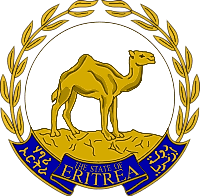
The current official National Coat of Arms/emblem of Eritrea was adopted on May 24, 1993. It is composed of an Arabian camel surrounded by an olive wreath. For the Eritrean nationalists, the camel is a symbol of success during the movement towards its independence from Ethiopia. At the bottom of the emblem, the name of the country is inscribed in golden letters on a blue scroll, in three spoken national languages: Tigrinya: ሃገረ ኤርትራ; English: The State of Eritrea; Arabic: دولة إرتريا،.
National Anthem
- Anthem Title: "Eritrea, Eritrea, Eritrea"
- Music Composer: Issac Abraham Meharezghi and Aron Tekle Tesfatsion.
- Lyricist: Solomon Tsehaye Beraki
- Date of Adoption: 1993
"Eritrea, Eritrea, Eritrea" is the national anthem of Eritrea. The music of the anthem have been composed by Issac Abraham Meharezghi and Aron Tekle Tesfatsion. The lyrics of the anthem have been authored by Solomon Tsehaye Beraki. The anthem was officially adopted in 1993.
ኤርትራ ኤርትራ ኤርትራ (Tigrinya )
ኤርትራ ኤርትራ ኤርትራ፡
በዓል ደማ እናልቀሰ ተደምሲሱ፡
መስዋእታ ብሓርነት ተደቢሱ።
1. መዋእል ነኺሳ ኣብ ዕላማ፡
ትእምርቲ ጽንዓት ኰይኑ ስማ፡
ኤርትራ’ዛ ሓበን ውጹዓት፡
ኣመስኪራ ሓቂ ከምትዕወት፡
ኤርትራ ኤርትራ
ኣብ ዓለም ጨቢጣቶ ግቡእ ክብራ።
2. ናጽነት ዘምጽኦ ልዑል ኒሕ፡
ንህንጻ ንልምዓት ክንሰርሕ፡
ስልጣኔ ከነልብሳ ግርማ
ሕድሪ’ሎና ግምጃ ክንስልማ፡
"Eritrea, Eritrea, Eritrea"
Eritrea, Eritrea, Eritrea,
Her enemy decimated,
and her sacrifices vindicated by liberation.
1. Steadfast in her goal,
symbolizing endurance,
Eritrea, the pride of her oppressed people,
proved that the truth prevails.
CHORUS:Eritrea, Eritrea,
holds her rightful place in the world.
2. Dedication that led to liberation,
Will build up and make her green,
We shall honor her with progress,
We have a word to her to embellish.
The Currency of Eritrea is the Eritrean nakfa
The current official currency of Eritrea is the Eritrean nakfa (Nfk, ERN). It was introduced as the official legal tender on November 8, 1997. The currency has been named after the Eritrean town of Nakfa which was the site of a first major victory that was achieved during the Eritrean War of Independence.
Each nakfa is subdivided into 100 cents. The Eritrean Nakfa has a fixed exchange rate with the US dollar of 15 ERN for every dollar. The Bank of Eritrea issues the currency and operates independently from the Ministry of Finance. The Eritrean currency comes in both coin and banknote form of various denominations.
Coins
Currently, coins in denominations of 5, 10, 25, and 50 cents and the 1 nakfa coin are circulated. Coins are found depicting the animals that are native to Eritrea.
Banknotes
Banknotes are in denominations of 1, 5, 10, 20, 50, and 100 nakfas. One side of the banknotes depict the various Eritrean ethnic groups and the reverse side of the notes depicts the natural scenery from various parts of the country. Banknotes were designed by Clarence Holbert, an African-American, and were produced by the Germany-based Giesecke and Devrient Printers. The Eritrean government has put up several measures to counter the increase in counterfeit currency and to reduce its illegal accumulation in foreign countries by issuing new banknotes.
Historical Currencies of Eritrea
During the 19th century, the Eritrean tallero was used as a currency. By the end of the 20th century, the use of the tallero ceased. When Ethiopia gained control of Eritrea, the Ethiopian birr – served as the official currency. The Eritrean Nakfa replaced the Ethiopian birr, as the official currency of Eritrea in 1997. The issuance of the Eritrean Nakfa has been in five series with the first issue being in 1997 and the latest in 2015. The 2015 series devalued all the previous issues of banknotes.
